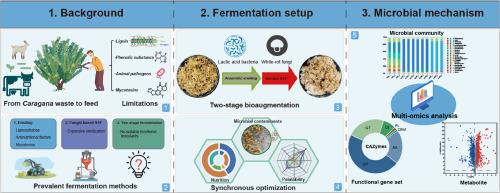通过两级生物增殖实现卡拉加纳废弃物的增值:优化营养成分、适口性和微生物污染物控制
IF 13
Q1 MATERIALS SCIENCE, PAPER & WOOD
引用次数: 0
摘要
Caragana korshinskii kom.(CKK)废弃物是中国西北地区常见的林业副产品,由于其最初的营养局限性和不可口的适口性,将其转化为反刍动物替代饲料面临着挑战。在实践中,腐熟和基于真菌的固态发酵(SSF)等传统策略无法有效解决这一问题。在此,我们设计了一种两阶段生物增殖(TBA)工艺,充分利用了腐熟和固态发酵的优势。在厌氧腌制阶段,CKK 废弃物接种了植物乳杆菌 LP1,有效抑制了曲霉菌和Nocardiopsis 等潜在的动物病原体,同时富集了Pediococcus 和 Lactiplantibacillus 等潜在的益生菌,富集度达到 95.7%。在随后的好氧 SSF 阶段,酵解的 CKK 接种了白腐真菌 Irpex lacteus F17,其富集度达到 87.9%。综合多组学分析表明,Irpex 是关键的类群,它拥有一个广泛的氧化还原酶系统,可改善营养成分、减少涩味酚类物质和减轻霉菌毒素。因此,CKK 的粗蛋白含量提高了 39.2%,木质素、总酚类物质和单宁酸含量分别降低了 24.4%、52.2% 和 51.4%。黄曲霉毒素 B1、玉米赤霉烯酮和呕吐毒素等霉菌毒素的含量几乎可以忽略不计,这证实了其安全性。总之,这项研究表明,TBA 策略可以成功地将具有挑战性且难吃的 CKK 废弃物转化为营养丰富且安全的菌丝体生物产品,从而使以前未得到充分利用的林业资源实现价值化,成为一种前景广阔的替代饲料。本文章由计算机程序翻译,如有差异,请以英文原文为准。

Valorization of the Caragana waste via two-stage bioaugmentation: Optimizing nutrition composition, palatability, and microbial contaminant control
Caragana korshinskii kom. (CKK) waste, a common forestry byproduct in northwest of China, presents challenges in its transformation into alternative ruminant feed due to its initial nutritional limitations and unappealing palatability. Conventional strategies, such as ensiling and fungal-based solid-state fermentation (SSF) cannot effectively address this issue in practice. Herein, a two-stage bioaugmentation (TBA) process was devised, leveraging the benefits of ensiling and SSF. During the anaerobic ensiling phase, CKK waste was inoculated with Lactiplantibacillus plantarum LP1, effectively suppressing potential animal pathogens such as Aspergillus and Nocardiopsis while enriching the material with potential probiotics like Pediococcus and Lactiplantibacillus, reaching an abundance of 95.7%. In the subsequent aerobic SSF stage, the ensiled CKK underwent inoculation with the white-rot fungus Irpex lacteus F17, which became enriched to 87.9%. Comprehensive multi-omics analysis identified Irpex as the key taxon, possessing an extensive redox enzyme system that led to the improvement in nutrient composition, reduction of astringent phenolic substances, and mitigation of mycotoxins. As a result, the crude protein content of the CKK increased by 39.2%, while lignin, total phenolic substances, and tannic acid content decreased by 24.4%, 52.2%, and 51.4%, respectively. The mycotoxin levels, including aflatoxin B1, zearalenone, and vomitoxin, were rendered negligible, confirming the safety. Overall, this study demonstrates the TBA strategy can successfully transform challenging and unpalatable CKK waste into a nutrient-enriched and safe mycelium-based bioproduct, thereby enabling the valorization of a previously underutilized forestry resource as a promising alternative feed.
求助全文
通过发布文献求助,成功后即可免费获取论文全文。
去求助
来源期刊

Journal of Bioresources and Bioproducts
Agricultural and Biological Sciences-Forestry
CiteScore
39.30
自引率
0.00%
发文量
38
审稿时长
12 weeks
 求助内容:
求助内容: 应助结果提醒方式:
应助结果提醒方式:


